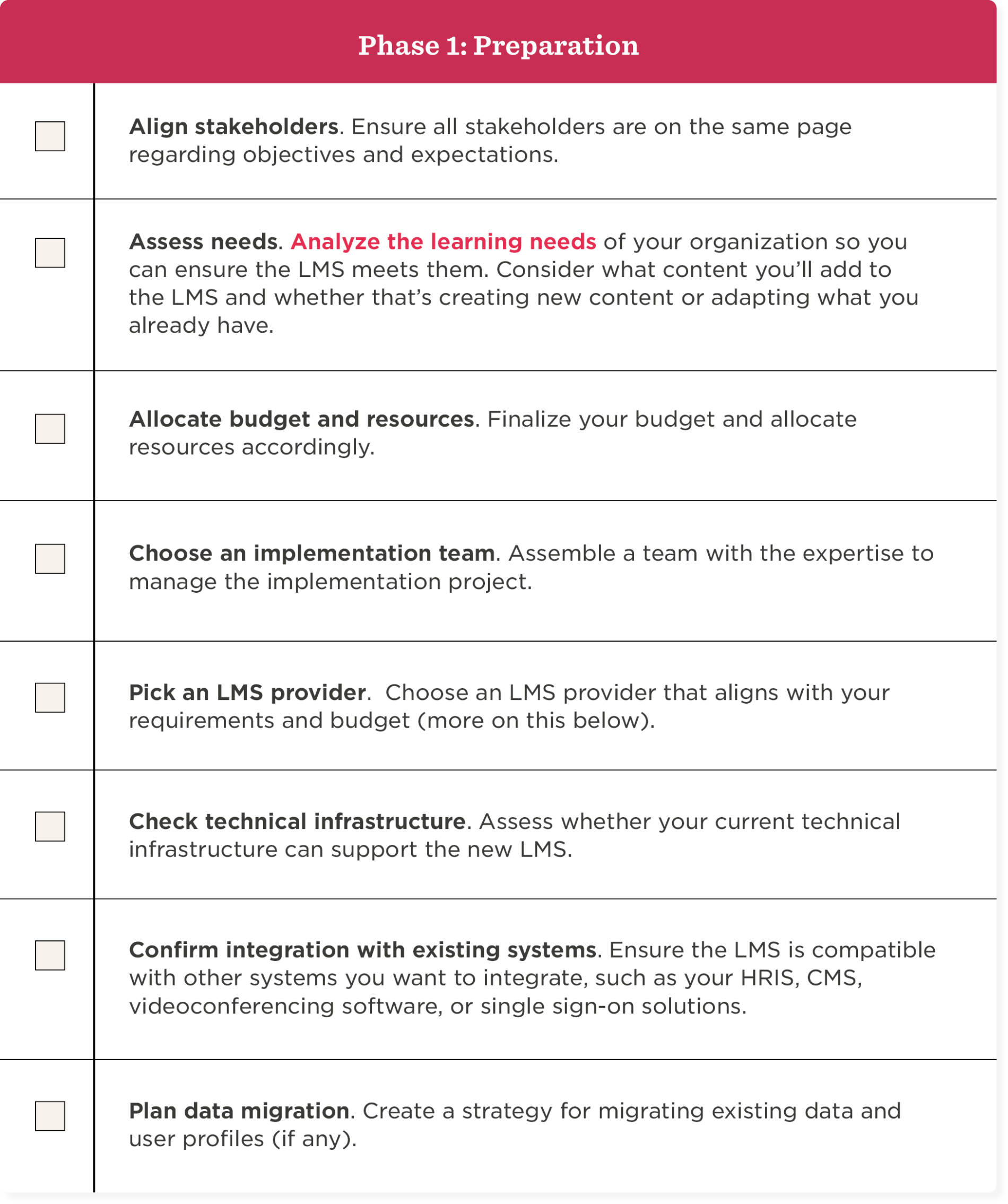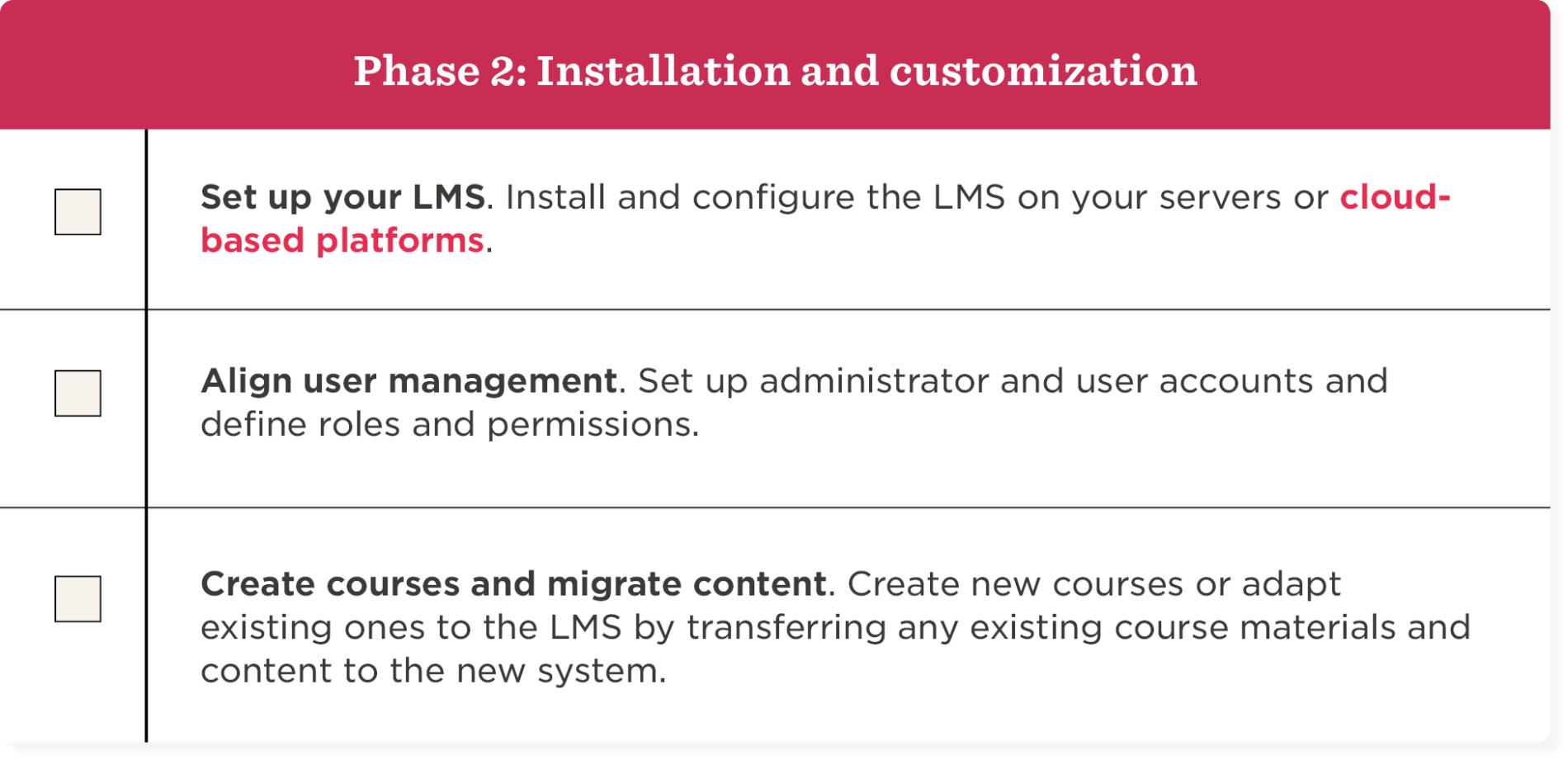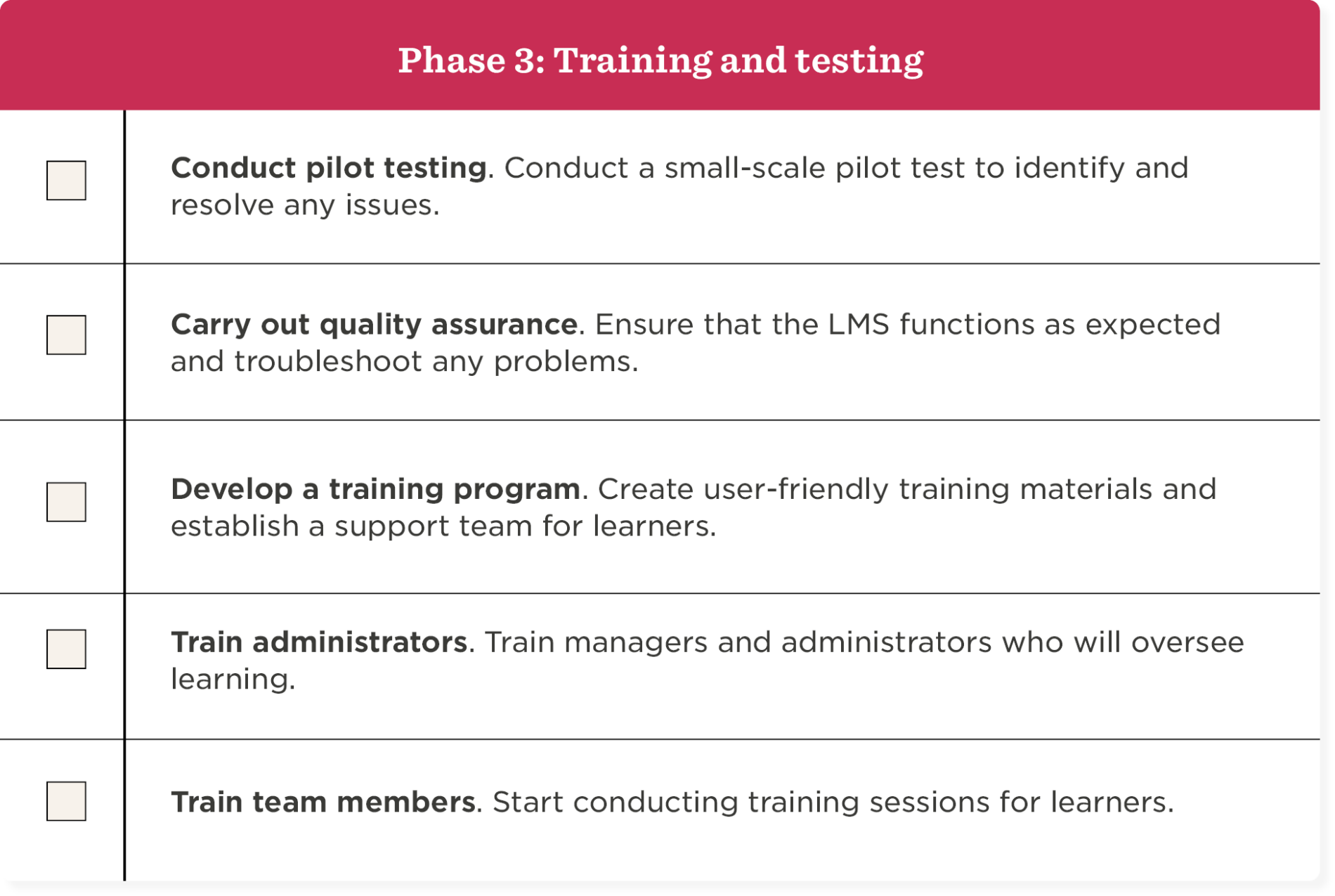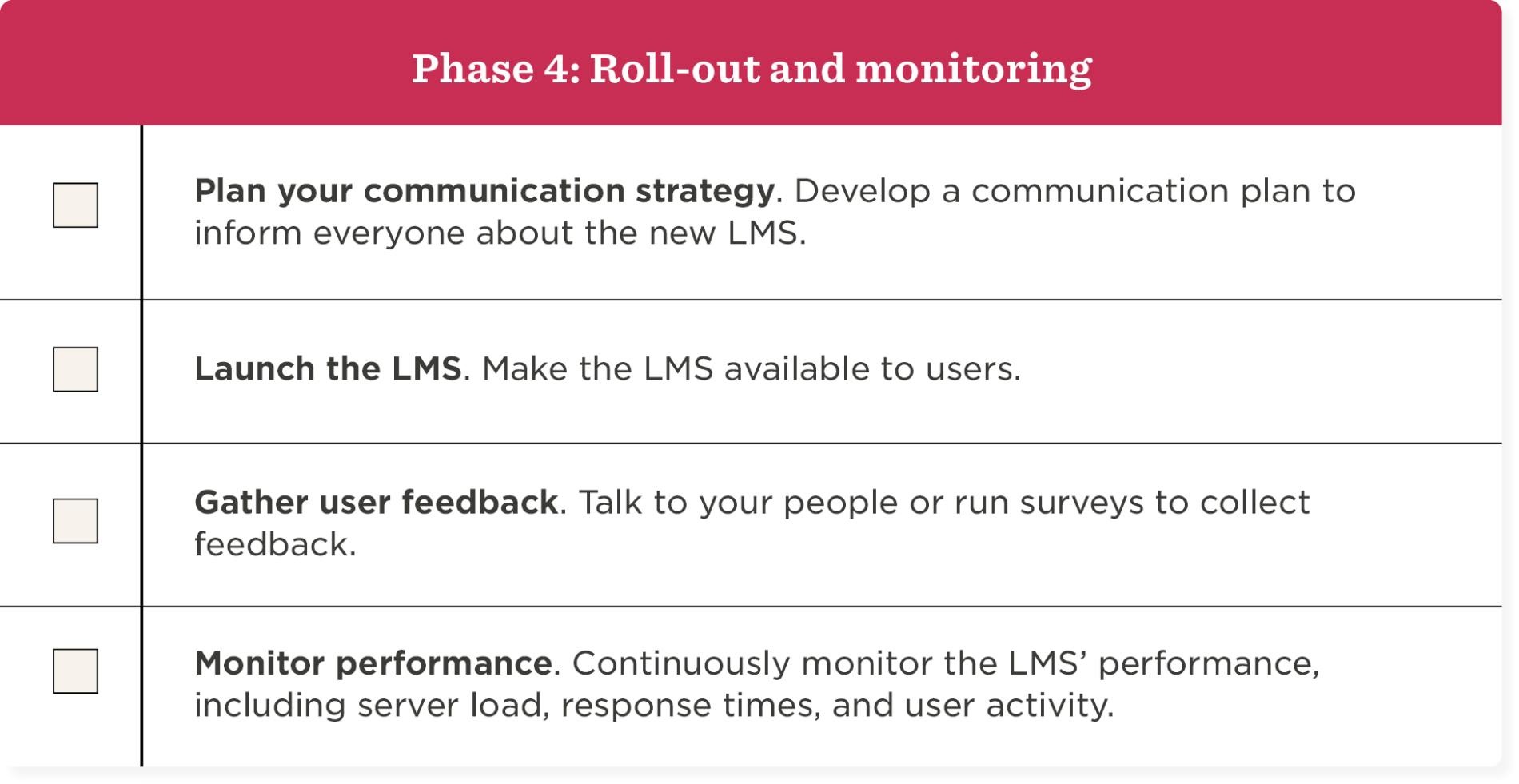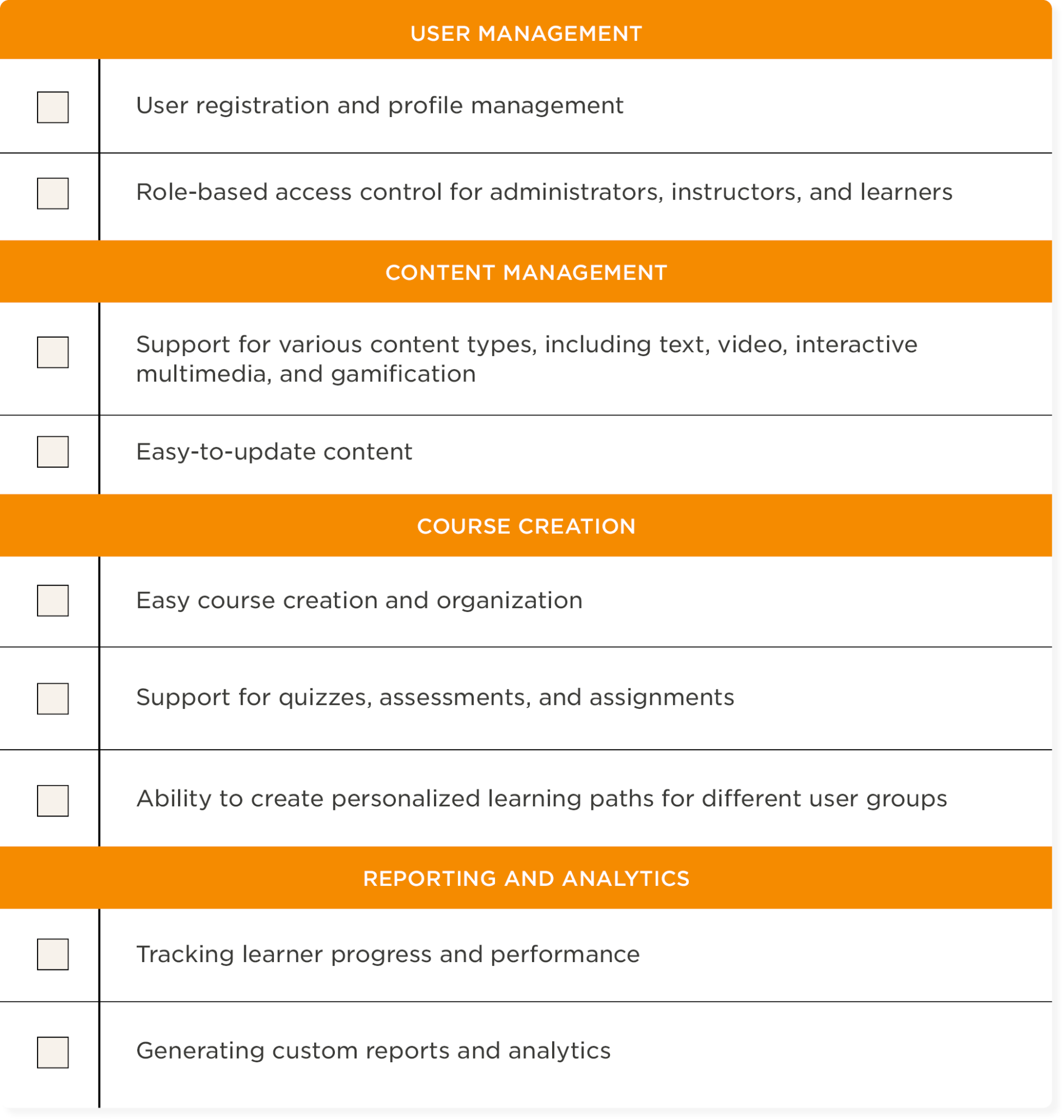Once you’ve made the decision to purchase a learning management system (LMS), what’s next? How do you find the right LMS for your organization? And how do you implement it smoothly?
Approaching LMS implementation the right way can be the difference between a smooth journey toward achieving your company’s learning and development goals and a stressful, bumpy process that creates more problems than it solves.
But don’t worry. This guide covers everything you need to know for successful LMS implementation—from planning to integration. You’ll find free checklists that cover all the essential aspects of the process so you can create a thorough plan that lays the foundations for a smooth journey.
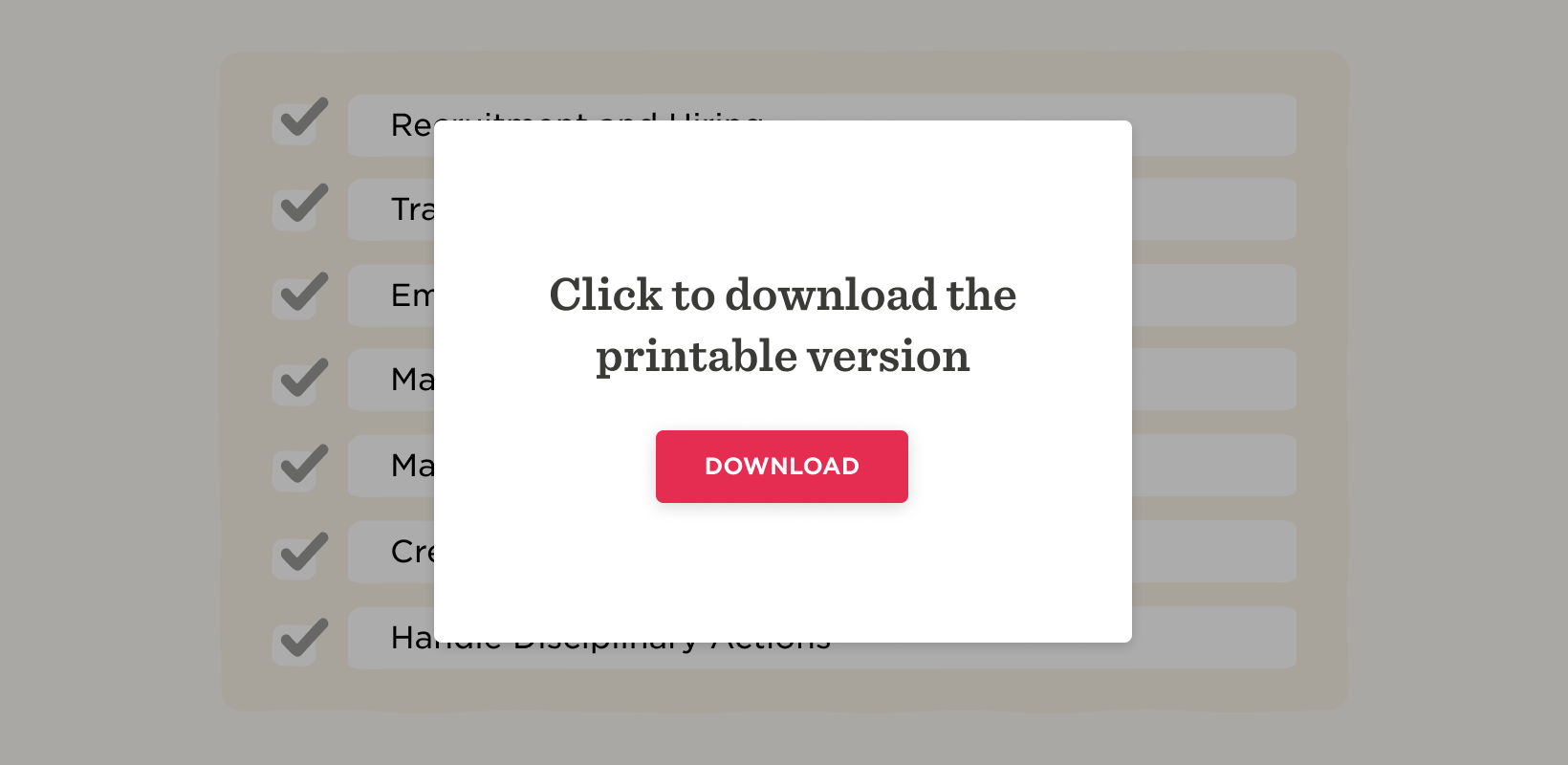
Creating an LMS implementation plan
Implementing an LMS isn’t a one-size-fits-all process. Like HRIS implementation, it requires careful planning to ensure it furthers your organization’s goals.
Here are the essential ingredients for an LMS implementation project plan that sets you up for success:
Clear objectives
Having a clear vision of what you want to achieve by implementing an LMS will help you stay on track.
Identify the training requirements of your people and the expectations your organization has for the LMS. Conduct surveys and interviews, analyze existing training materials, and talk to stakeholders to gather information.
Budget and resource allocation
Determine the financial budget for the implementation process. Consider the costs that come with software licensing, hardware, training, and ongoing maintenance.
Stakeholder engagement
It’s a good idea to involve all the relevant stakeholders in the planning process. This ensures you consider their needs and expectations and helps prevent overlooking any aspects of the implementation process by mistake.
Timeline
Establish a realistic timeline for implementation by breaking down the project into manageable milestones, each with its own set of tasks and deadlines. This will help you track progress and ensure the project stays on course.
Risk assessment
Identifying and planning for any potential challenges that could affect the implementation from the start will give you the best chances of mitigating those challenges. Consult with stakeholders and consider challenges such as integration issues, resistance to change, or data security concerns.
Training and support
Good things take time, and helping everyone become familiar with a new LMS is no exception.
It’s important to set aside plenty of time for training in your plan. Establish a support team to provide your people with ongoing assistance and resolve issues.
Delegation
Once you have the bones of your plan in place, put together an implementation team and assign roles and tasks to the appropriate people. Incorporating this into your plan will minimize disruptions throughout the process.
Evaluation
A good plan sets aside time for gathering feedback and monitoring KPIs to evaluate the success of the implementation. This will enable you and your team to refine the LMS implementation process so you get the best return on your investment.
<< Download and print these checklists to build an effective implementation plan >>
LMS implementation checklist
There are a lot of details to consider for the implementation process, but the checklist below covers each phase, so you can rest assured that you’re covering the different aspects of the process.
Key steps in LMS implementation
Here are the key LMS implementation steps that will contribute to the successful launch and integration of the new system:
1. Identify key metrics
Once you’ve established the learning objectives of your company, you can identify the KPIs that will help you track the progress of your implementation and evaluate its success.
Depending on your goals, these metrics could include:
- Course completion rates
- Average engagement levels
- Time spent on the course
- Improvement in job performance
2. Assemble your implementation team
Evaluate the different phases of your implementation plan and consider the variety of people who have the expertise to ensure each phase runs smoothly. Assemble your implementation team and assign roles, responsibilities, and tasks.
3. Configure and customize the system
Work with the LMS vendor and your IT department to configure and customize the system to your organization’s specific requirements. This includes defining user roles, creating content templates, and setting up the user interface.
4. Check integration with existing systems
Make sure the LMS is compatible with other software systems you want to integrate, such as videoconferencing software, HRIS, CRM, and single sign-on solutions.
5. Create and migrate content
Develop new content or migrate existing training programs to the LMS.
Now is an excellent time to determine whether any older courses you have are engaging enough or need to be updated with new content. It’s worth thinking about different content formats, too, such as text, video, quizzes, and gamification.
If you’re transferring existing courses, ensure that the content is compatible with the new system.
6. Migrate data
If you’re transitioning from an older LMS or transferring data from your HRIS to the new LMS, it’s important to have a data migration strategy that protects existing user data from loss or corruption.
7. Create user profiles
Start enrolling users into the LMS by setting up administrator and learner profiles. Check that profile permissions and access rights match up to the user roles you’ve defined.
8. Train administrators and users
Provide training to administrators who will oversee learning via the LMS. This training should cover how to create and manage courses, enroll users, and access training modules.
Once administrators are familiar with the new platform, establish a support team to begin training users throughout the organization.
9. Conduct pilot testing
Conduct a pilot test with a small group of users to identify and resolve any issues and gather feedback. This gives you the opportunity to fine-tune the LMS before deployment.
10. Deploy your LMS
It’s time to launch the LMS throughout your organization. You can do this in phases or all at once, depending on your company’s needs and capacity. Share the launch date with everyone and provide support after the launch.
11. Establish monitoring and continuous improvement
Monitor the LMS’ performance and usage based on the KPIs you set previously. Collect data on user engagement and completion rates and feedback from users and stakeholders.
Use this data to enhance the LMS and improve the user experience to meet learning needs.
Selecting the right LMS
With countless options to choose from, how do you know which LMS is right for your organization? When considering your different options, it helps to keep the factors below in mind:
Focus on your learning objectives
Do you want to train people in a particular product you offer? Or improve engagement when it comes to compliance training within your company?
Whatever your goals, keeping your learning objectives in mind during the selection process can narrow down the many options for you.
Consider scalability
It’s important to consider the long-term future as well as your immediate needs when choosing an LMS.
Consider the growth of your user base over time. Make sure the LMS has the capacity for more users and content without compromising performance or user experience.
Look for a user-friendly interface
Making learning and development more engaging for people is a common motivation for purchasing an LMS.
That’s why it’s important to investigate the user-friendliness of a platform. A well-designed and intuitive interface makes the learning experience more enjoyable and easier for administrators and learners to familiarize themselves with the system.
If you have a UX and UI team within your organization, ask for their perspective on the user-friendliness of the LMS you’re considering.
Think about remote accessibility
An LMS that has mobile accessibility improves engagement by making it easy for everyone to access training whenever and wherever it’s convenient.
Check content management
Consider what content you’ll offer in your courses and whether the LMS supports it and allows you to manage and organize it easily. A good LMS supports a variety of content types, including text, images, videos, interactive multimedia, and even gamification.
Assess reporting and analytics
An LMS with good reporting and analytics tools allows you to assess the effectiveness of a course and monitor learner progress and performance.
This kind of data is invaluable for improving the learning experience and making informed decisions regarding your organization’s overall learning and development.
Remember compliance and security
If you deal with sensitive learner data, compliance with data protection regulations and security standards is a non-negotiable feature for your LMS. Make sure that any LMS you’re considering comes with data encryption and secure user authentication to protect user information.
Seek support and training
A new LMS can present a steep learning curve for learners and administrators alike. Find out what level of support and training the LMS vendor provides. Look for a vendor that offers comprehensive support resources such as helpdesk services, user documentation, and online tutorials.
Effective training and support are essential for a smooth transition to the new system.
Confirm compatibility and customization
Think about what third-party software and systems you want the LMS to integrate with, such as video conferencing software like Zoom and Microsoft Teams or your own HRMS or HRIS. Consider whether you need to customize the LMS with additional features and if the vendor can assist you.
Most importantly, check that the LMS is compatible with your IT infrastructure.
Calculate cost
As with any purchase, you’ll want to consider the cost of the LMS. But don’t just evaluate the initial purchase price—calculate the total cost of licensing fees, hosting, ongoing maintenance, and potential upgrades, too.
LMS features and requirements checklist
This LMS features checklist will help you assess potential providers so you can choose one that aligns with your needs:
Recommended For Further Reading
LMS integration checklist
It’s crucial for an LMS to be able to integrate with your existing systems. Otherwise, it could create technical issues that will hinder rather than help your organization’s learning and development program.
Here’s a checklist to ensure your LMS integrates with your existing systems:
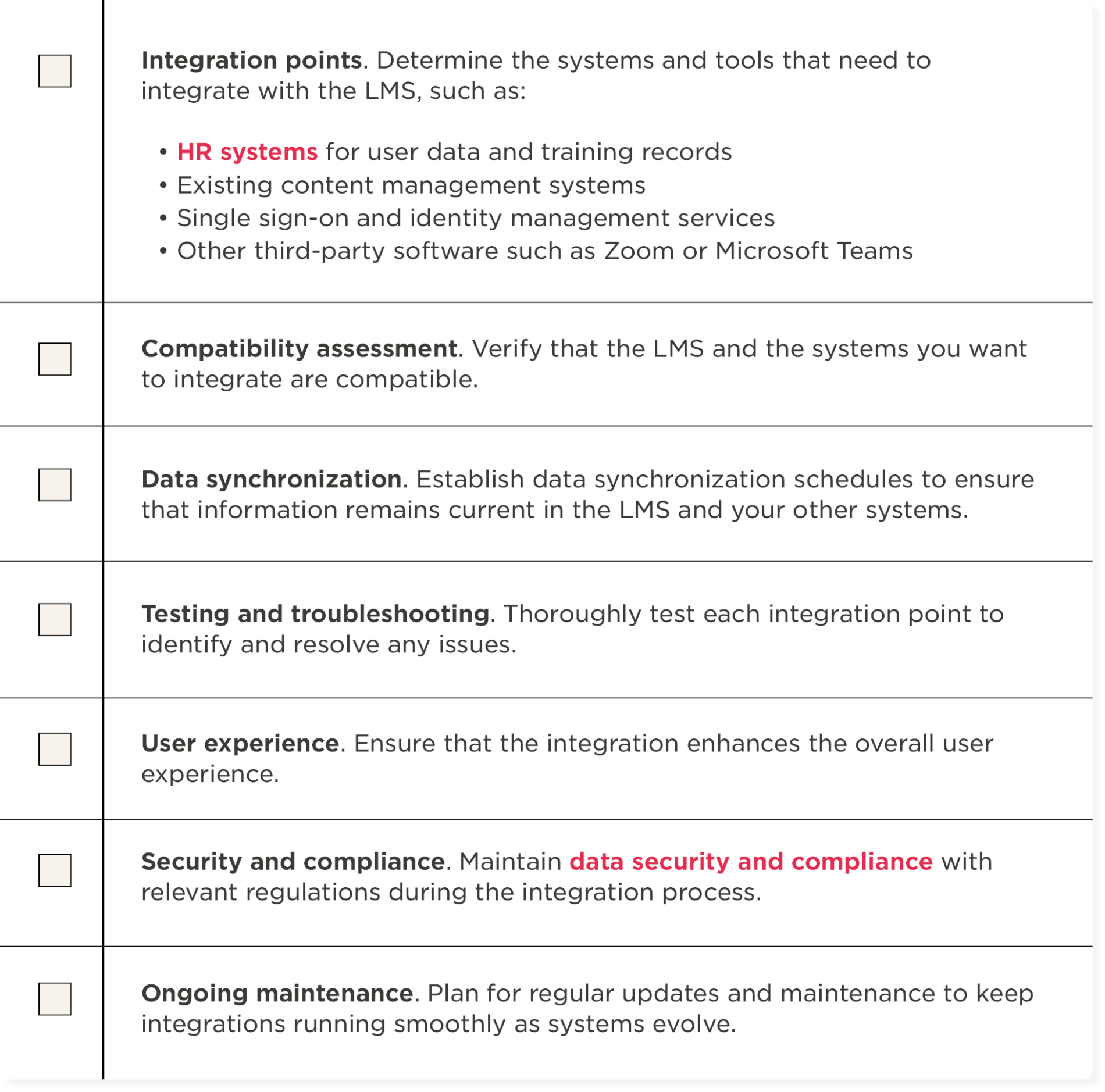
Implementation without hesitation
Learning management system implementation can feel daunting at the outset. But with a thorough plan and knowledge of what to look out for, the process can be smoother than you might expect.
It’s important to:
- Have clear, specific goals for your LMS, as this will influence the rest of the implementation process
- Involve key stakeholders and experts throughout every phase
- Choose an LMS that is compatible with your goals and systems
- Identify potential challenges in the process from the beginning
- Pilot-test the LMS, gather feedback from users, and make improvements as necessary
By using the checklists in this guide, you’ll build an effective implementation plan that gives you confidence as you start the process.
With a successful implementation, you’ll unlock the full potential of e-learning within your organization, improving learning outcomes and overall performance.
<< Download and print these checklists to build an effective implementation plan >>

